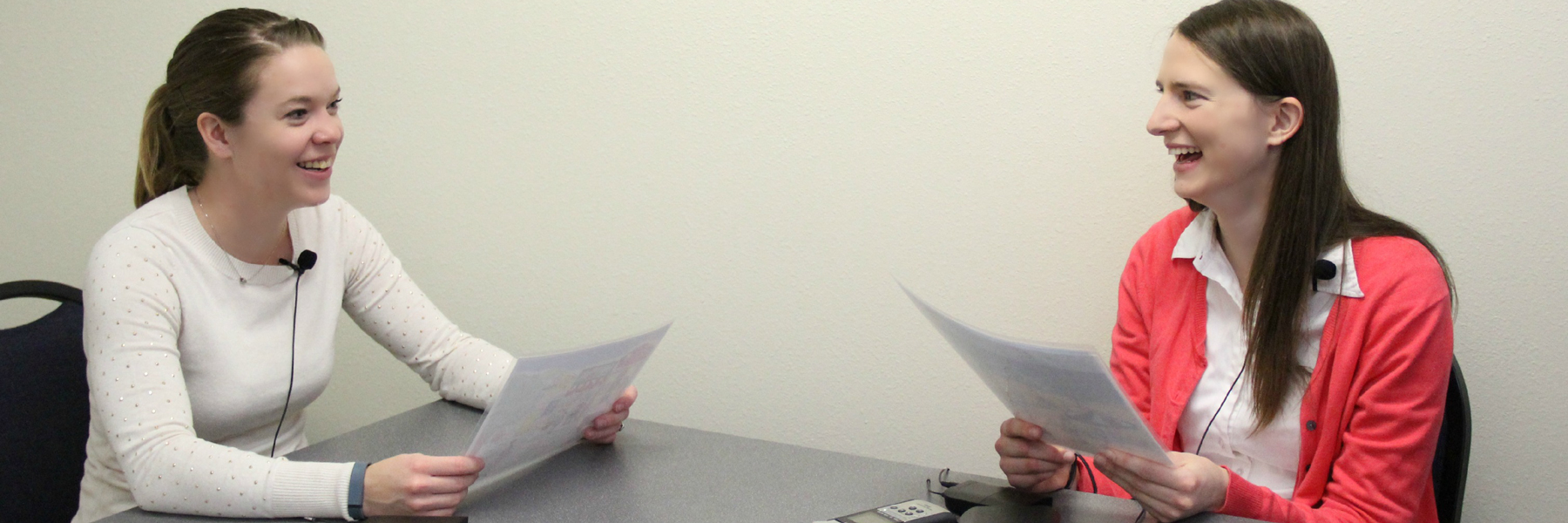About the Lab
Human interaction requires communication partners to produce and perceive speech and to coordinate these behaviors to succeed. What happens when the ability to produce or perceive speech is impaired? And how does this disrupt the collaborative process of communication? In this research lab, we investigate speech communication as a dynamic activity involving both speaker and listener. I have built a program of research investigating how listeners understand and adapt to neurologically degraded speech laying the groundwork for listener-targeted perceptual training to improve intelligibility of dysarthria. I have also expanded this line of work to examine how communication partners collaborate and coordinate their speech behavior during conversation. These two key lines of research, which frequently overlap, emphasize the role of rhythm in communication and draw from a breadth of disciplines, including speech science, cognitive psychology, linguistics, and engineering. Work in the Human Interaction Lab is currently funded by the National Institutes of Health (NIDCD).
Learn more about the lab
Opportunities
We are always looking for people for neurogenic speech disorders to participate in our research. If you live in the Logan area and have a speech disorder from any type of brain injury or disease then we welcome your participation. If you're interested or have any questions please send an email to: stephanie.borrie@usu.edu.
Publications
* Graduate student mentee. Documents are provided for personal or educational use only. Downloading a document is considered a request for a single copy.
- 2022
- *Wynn C.J., Barrett, T.S., & Borrie, S.A. (in press). Rhythm perception, speaking rate entrainment, and conversational quality: A mediated model. Journal of Speech, Language, and Hearing Research.
- *Wynn C.J., *Josephson, E.R. & Borrie, S.A. (2022). An examination of articulatory precision in autistic children and adults. Journal of Speech, Language, and Hearing Research. 65, 1416–1425. pdf
- Borrie S.A., *Wynn C.J., Berisha, V., & Barrett, T.S. (2022). From speech acoustics to communicative participation in dysarthria: Towards a causal framework. Journal of Speech, Language, and Hearing Research, 65, 405-418. pdf
- 2021
- Borrie S.A. & Lansford, K.L. (2021). A perceptual learning approach for dysarthria remediation: An updated review of experimental studies. Journal of Speech, Language, and Hearing Research, 64, 3060-3073. pdf
- Borrie S.A., Lansford, K.L., & Barrett, T.S. (2021). A clinical advantage: Experience informs recognition and adaptation to a novel talker with dysarthria. Journal of Speech, Language, and Hearing Research, 64, 1503–1514. pdf
- Lubold, N., Willi, M.M., Borrie, S.A., Barrett, T.S., & Berisha, V. (2021). Healthy communication partners modify their speech when conversing with individuals with Parkinson's disease. Journal of Speech, Language, and Hearing Research, 64, 1539–1549. pdf
- Knollhoff, S., Borrie, S.A., Barrett, T.S., & Searl, J. (2021). Listener impressions of alaryngeal communication modalities. International Journal of Speech-Language Pathology, 23, 540-547.
- *Hirsh, M.E., Lansford, K.L., Barrett, T.S., & Borrie, S.A. (2021). Generalized learning of dysarthric speech between male and female talkers. Journal of Speech, Language, and Hearing Research, 64, 444–451. pdf
- 2020
- Borrie, S.A., *Wynn, C.J., Berisha, V, Lubold, N., Willi, M.M., Coelho, C.A., & Barrett, T.S. (2020). Conversational coordination of articulation responds to context: A clinical test case with traumatic brain injury. Journal of Speech, Language, and Hearing Research, 63, 2567–2577. pdf
- Lansford, K.L., Borrie, S.A., Barrett, T.S., & Flechaus, C. (2020). When additional training isn’t enough: Further evidence that unpredictable speech inhibits adaptation. Journal of Speech, Language, and Hearing Research, 63, 1700-1711. pdf
- *Wynn, C.J., & Borrie, S.A. (2020). Methodologies matter: The impact of research design on conversational entrainment outcomes. Journal of Speech, Language, and Hearing Research, 63, 1352–1360. pdf
- Borrie, S.A., Barrett, T.S., Liss, J.M., & Berisha, V. (2020). Sync pending: Characterizing conversational entrainment in dysarthria using a multidimensional, clinically-informed approach. Journal of Speech, Language, and Hearing Research, 63, 83-94. pdf
- 2019
- Lansford, K.L., Borrie, S.A., & Barrett, T.S. (2019). Regularity matters: Unpredictable speech degradation inhibits adaptation to dysarthric speech. Journal of Speech, Language, and Hearing Research, 62, 4282-4290. pdf
- *Wynn, C.J., Borrie, S.A., & *Pope, K.A. (2019). Going with the flow: An examination of entrainment in typically developing children. Journal of Speech, Language, and Hearing Research, 62, 3706–3713. pdf
- Borrie, S.A., Barrett, T.S., Willi, M.M., & Berisha, V. (2019). Syncing up for a good conversation: A clinically-meaningful methodology for capturing conversational entrainment in the speech domain. Journal of Speech, Language, and Hearing Research, 62, 283–296. pdf
- Borrie, S.A., Barrett, T.S., & Yoho, S.E. (2019). Autoscore: An open-source automated tool for scoring listener perception of speech. Journal of Acoustical Society of America, 145, 392-399. http://autoscore.usu.edu/ pdf
- Yoho, S.E., Borrie, S.A., Barrett, T.S., & Whittaker, D. (2019). Are there sex effects for speech intelligibility in American English? Examining the influence of talker, listener, and methodology. Attention, Perception, & Psychophysics, 81, 558-570. pdf
- Lubold, N., Borrie, S.A., Barrett, T.S., Willi, M.M., & Berisha, V. (2019). Do conversational partners entrain on articulatory precision? Proceedings of INTERSPEECH 2019. Paper number 1786, 1931–1935. pdf
- 2018
- Borrie, S.A., Lansford, K.L. & Barrett, T.S. (2018). Understanding dysrhythmic speech: When rhythm does not matter and learning does not happen. Journal of Acoustical Society of America. 143, EL379-EL385. pdf
- McLaughlin, D.J, Baese-Berk, M.M, Bent, T., Borrie, S.A., & Van Engen, K. (2018). Coping with adversity: Individual differences in the perception of noisy and accented speech. Attention, Perception, & Psychophysics, 80, 1559-1570. pdf
- *Wynn, C.J., Borrie, S.A., & Sellars, T. (2018). Speech rate entrainment in children and adults with and without autism spectrum disorder. American Journal of Speech-Language Pathology, 27, 965-974. pdf
- Willi, M.M., Borrie, S.A., Barrett, T.S., Tu, M. & Berisha, V. (2018). A discriminative acoustic-prosodic approach for measuring local entrainment. Proceedings of INTERSPEECH 2018. Paper number 1419, 1–5. pdf
- *Parker, M.A. & Borrie, S.A. (2018). Judgements of intelligence and likeability in young adult female speakers of American English: The influence of vocal fry and the surrounding acoustic-prosodic context. Journal of Voice, 32 538-545. pdf
- Lansford, K.L., Luhrsen, S., Ingvalson, E., & Borrie, S.A. (2018). Effects of familiarization on intelligibility of dysarthric speech in older adults with and without hearing loss. American Journal of Speech-Language Pathology, 27, 91-98. pdf
- Yoho, S.E. & Borrie, S.A. (2018). Combining degradations: The effect of background noise on intelligibility of disordered speech. Journal of Acoustical Society of America, 143, 281-286. pdf
- 2017
- Borrie, S.A., Lansford, K.L. & Barrett, T.S. (2017). Generalized adaptation to dysarthric speech. Journal of Speech, Language, and Hearing Research, 60, 3110-3117. pdf
- Borrie, S.A. & Schäfer, M.C.M. (2017). Effects of lexical and somatosensory feedback on long-term improvements in intelligibility of dysarthric speech. Journal of Speech, Language, and Hearing Research, 60 2151-2158. pdf
- Borrie, S.A., Baese-Berk, M. Van Engen, K., & Bent, T. (2017). A relationship between processing speech in noise and dysarthric speech. Journal of the Acoustical Society of America, 141, 4660-4667. pdf
- Borrie, S.A. & *Delfino, C. (2017). Conversational entrainment of vocal fry in young adult female American English speakers. Journal of Voice, 31, 513.e25–513.e32. pdf
- Muñoz, K., Ong, C., Borrie, S.A., Nelson, L.H., & Twohig, M. (2017). Audiologists’ communication behavior during hearing device management appointments. International Journal of Audiology, 56, 328-336. pdf
- Borrie, S.A., Lansford, K.L. & Barrett, T.S. (2017). Rhythm perception and its role in recognition and learning of dysrhythmic speech. Journal of Speech, Language, and Hearing Research, 60, 561–570. pdf
- 2016
- Bent, T., Baese-Berk, M., Borrie, S.A., & McKee, M. (2016). Individual differences in the perception of unfamiliar regional, nonnative, and disordered speech varieties. Journal of the Acoustical Society of America, 140, 3775-3786. pdf
- Lansford, K.L., Borrie, S.A., & Bystricky, L. (2016). Use of crowdsourcing to assess the ecological validity of perceptual training paradigms in dysarthria. American Journal of Speech-Language Pathology, 25, 233-239. pdf
- 2015
- Borrie, S.A. & Schäfer, M.C.M. (2015). The role of somatosensory information in speech perception: Imitation improves recognition of disordered speech. Journal of Speech, Language, and Hearing Research, 58, 1708–1716. pdf
- Borrie, S.A., Lubold, N. & Pon-Barry, H. (2015). Disordered speech disrupts conversational entrainment: A study of acoustic-prosodic entrainment and communicative success in populations with communication challenges. Frontiers in Psychology, 6:1187. pdf
- Borrie, S.A. (2015). Visual information: A help or hindrance to perceptual processing of dysarthric speech. Journal of Acoustical Society of America, 137, 1473-1480. pdf
- Baese-Berk, M., Bent, T., Borrie, S.A., & McKee, M. (2015). Individual differences in perception of unfamiliar speech. In The Scottish Consortium for ICPhS 2015 (Ed.), Proceedings of the 18th International Congress of Phonetic Sciences. Paper number 0460, 1–5. pdf
- 2014
- Borrie, S.A. & Liss, J.M., (2014). Rhythm as a coordinating device: Entrainment with disordered speech. Journal of Speech, Language, and Hearing Research, 57, 815-824. pdf
- 2013
- Borrie, S.A., McAuliffe, M.J., Liss, J.M., O’Beirne, G.A., & Anderson, T. (2013). The role of linguistic and indexical information in improved recognition of dysarthric speech. Journal of Acoustical Society of America, 133, 474-482. pdf
- 2012
- Borrie, S.A., McAuliffe, M.J., Liss, J.M., Kirk, C., O'Beirne, G.A., & Anderson, T. (2012). Familiarisation conditions and the mechanisms that underlie improved recognition of dysarthric speech. Language and Cognitive Processes, 27, 1039-1055. pdf
- Borrie, S.A., McAuliffe, M.J., Liss, J.M., O'Beirne, G.A., & Anderson, T. (2012). A follow-up investigation into the mechanisms that underlie improved recognition of dysarthric speech. Journal of the Acoustical Society of America, 132, EL102-108. pdf
- Borrie, S.A., McAuliffe, M.J., & Liss, J.M. (2012). Perceptual learning of dysarthric speech: A review of experimental studies. Journal of Speech, Language, and Hearing Research, 55, 290-305. pdf
- 2010
- McAuliffe, M.J., Borrie, S.A., Good, P.V., & Hughes, L.E. (2010). Consideration of the listener in the assessment and treatment of dysarthria. ACQuiring Knowledge in Speech, Language, and Hearing, 12, 16-19. pdf
- 2007
- Borrie, S.A., McAuliffe, M.J., Tillard, G., Ormond, T., Anderson, T., & Hornibrook, J. (2007). Effect of the Lee Silverman Voice Treatment (LSVT®) on articulation in speakers with Parkinson’s disease. New Zealand Journal of Speech-Language Therapy, 62, 29-36. pdf
Lab Director



